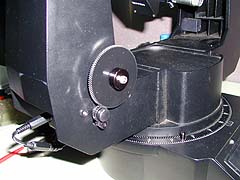Posted inAstronomy Telescope Mods & Repair
Meade LX50 DEC Axis Issues
Hoo boy, did I have a sick DEC axis. I think I only began to notice it when I started guiding long-exposure shots as it was on the most part livable for the visual stuff.
I had a few problems:
- Reversing direction quickly back and forth several times would actually “crash” the LX50! The power led would start blinking and all I could do was power off, wait a few seconds and power on to get it to respond. Kind of like an operating system or two that I won’t mention here! 😉
- Speed of motion on the DEC axis had nothing to do with the RA axis. Either it was Speedy Gonzalez or the motor would actually come to a grinding (seriously — grinding) halt.
- When I reversed direction it would take a long time before whatever was in the FOV actually moved. It was like slack was being picked up somewhere in the tangent arm.
None of this is very good when you’re trying to guide a photo on a guide star you can barely see, and I won’t even go into what an autoguider will try to do…

